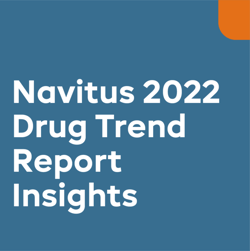During this two-part blog series, we'll discuss the opioid epidemic in its current state, the impact that coronavirus (COVID-19) is having on the opioid crisis and explain strategies for plan sponsors to help combat opioid abuse and misuse during these unprecedented times.
Opioid Epidemic in its Current State
In 2018, more than one in five people in the United States filled an opioid prescription, and roughly 40 people died daily after taking prescription opioids.1 Recent data shows a spike in opioid use and overdoses, with at least 35 states reporting increases in opioid mortality rates, and an 11.4% year-over-year increase in drug overdose fatalities for the first four months of 2020.2,3
In many cases, people who die from opioid-related deaths start with a legal prescription opioid, typically to manage pain after surgery or ongoing chronic pain, such as low back pain, and eventually become addicted. However, simply refusing opioid access or coverage is not the answer to this complex issue. Insurers and pharmacy benefit managers (PBMs) have the opportunity to play an important role in effectively tackling opioid abuse and misuse.
Impact of COVID-19
The impact of COVID-19 is causing a ripple effect of economic and health concerns. In the first half of 2020, opioid overdose rates were significantly higher compared to the same time last year, with an 18% increase in March, 29% in April and 42% in May.3 The spike in opioid overdoses is attributed to feelings of isolation, fear of unemployment and other pandemic-related stressors.3 The uncertainty is increasing anxiety, especially among already vulnerable populations. Budget cuts are heavily affecting mental and behavioral health services and opioid treatment programs, which are essential to combat the opioid epidemic and its abuse prevention and crisis intervention programs.2
It’s important that members continue to take medications as prescribed and continue therapy, treatment or support appointments, either in-person or through telehealth services, during the pandemic. However, with the pandemic comes new barriers to treatment that make an already challenging time more difficult, where people are faced with tough decisions – balancing their health with their livelihood.
Some barriers include:
 Limited access to treatment facilities
Limited access to treatment facilities
Treatment facilities are reducing capacity to adhere to social distancing requirements, while demand for the few available spots continues to rise. A recent study found that 34% of people reported changes or disruptions in accessing treatment during the pandemic, with about 14% saying they are unable to access treatment at all.4
 Lack of coverage and high cost for non-opioid pain treatments
Lack of coverage and high cost for non-opioid pain treatments
In some cases, insurance covers opioid medications more readily, whereas other non-opioid pain treatments, that are often safer and more effective, are not covered. The additional cost and time off work necessary for some non-opioid pain treatments can deter people from considering these options.2
Insufficient access to telehealth for certain areas and populations
Telehealth is a viable option for many people to receive counseling or treatment virtually. However, some rural areas struggle with limited bandwidth, internet access and/or internet affordability, which can inhibit patients from getting the treatments they need.
 Prolonged opioid dependency with postponed elective surgeries
Prolonged opioid dependency with postponed elective surgeries
Elective surgeries aren’t just cosmetic surgeries. They can also include hip, knee and shoulder surgeries, neurosurgical and spinal surgeries, colorectal surgeries and tumor removals, just to name a few. In many instances, patients are prescribed opioids to manage their pain while awaiting treatment or surgery.5 Delayed elective surgeries mean patients will be taking their opioid prescriptions for longer, which greatly increases the odds of dependency.
So, the question is – what can you do to combat these barriers and promote safe, effective and appropriate opioid use among your members?
Stay tuned for next week’s blog to learn more!
- Mann B. Doctors and dentists still flooding U.S. with opioid prescriptions. NPR. https://www.npr.org/2020/07/17/887590699/doctors-and-dentists-still-flooding-u-s-with-opioid-prescriptions. Published July 17, 2020. Accessed July 20, 2020.
- Sokolow A. Opioid overdoses have skyrocketed amid the coronavirus, but states are nevertheless slashing addiction treatment program budgets. STAT News. https://www.statnews.com/2020/07/16/opioid-overdoses-have-skyrocketed-amid-the-coronavirus-but-states-are-nevertheless-slashing-addiction-treatment-program-budgets/. Published July 16, 2020. Accessed July 20, 2020.
- Brown A. Opioid abuse is soaring amid the pandemic: How to help turn the tide. BenefitsPRO. https://www.benefitspro.com/2020/09/16/opioid-abuse-is-soaring-amid-the-pandemic-how-to-help-turn-the-tide/?kw=Opioid%20abuse%20is%20soaring%20amid%20the%20pandemic:%20How%20to%20help%20turn%20the%20tide&utm_source=email&utm_medium=enl&utm_campaign=bprodaily&utm_content=20200917&utm_term=bpro. Published September 16, 2020. Accessed September 17, 2020.
- Gajewski M. States scramble to deal with the compounding COVID and opioid epidemic. Forbes. https://www.forbes.com/sites/mishagajewski/2020/07/29/states-scramble-to-deal-with-the-compounding-covid-and-opioid-epidemic/#1d69fb587f56. Published July 29, 2020. Accessed August 5, 2020.
- Asar A. Postponing elective surgeries due to COVID-19 might have pushed the opioid crisis to the next level. Fortune. https://fortune.com/2020/08/08/elective-surgeries-opioid-crisis-coronavirus/. Published August 8, 2020. Accessed August 11, 2020.Navitus 2019 Drug Trend Report.





